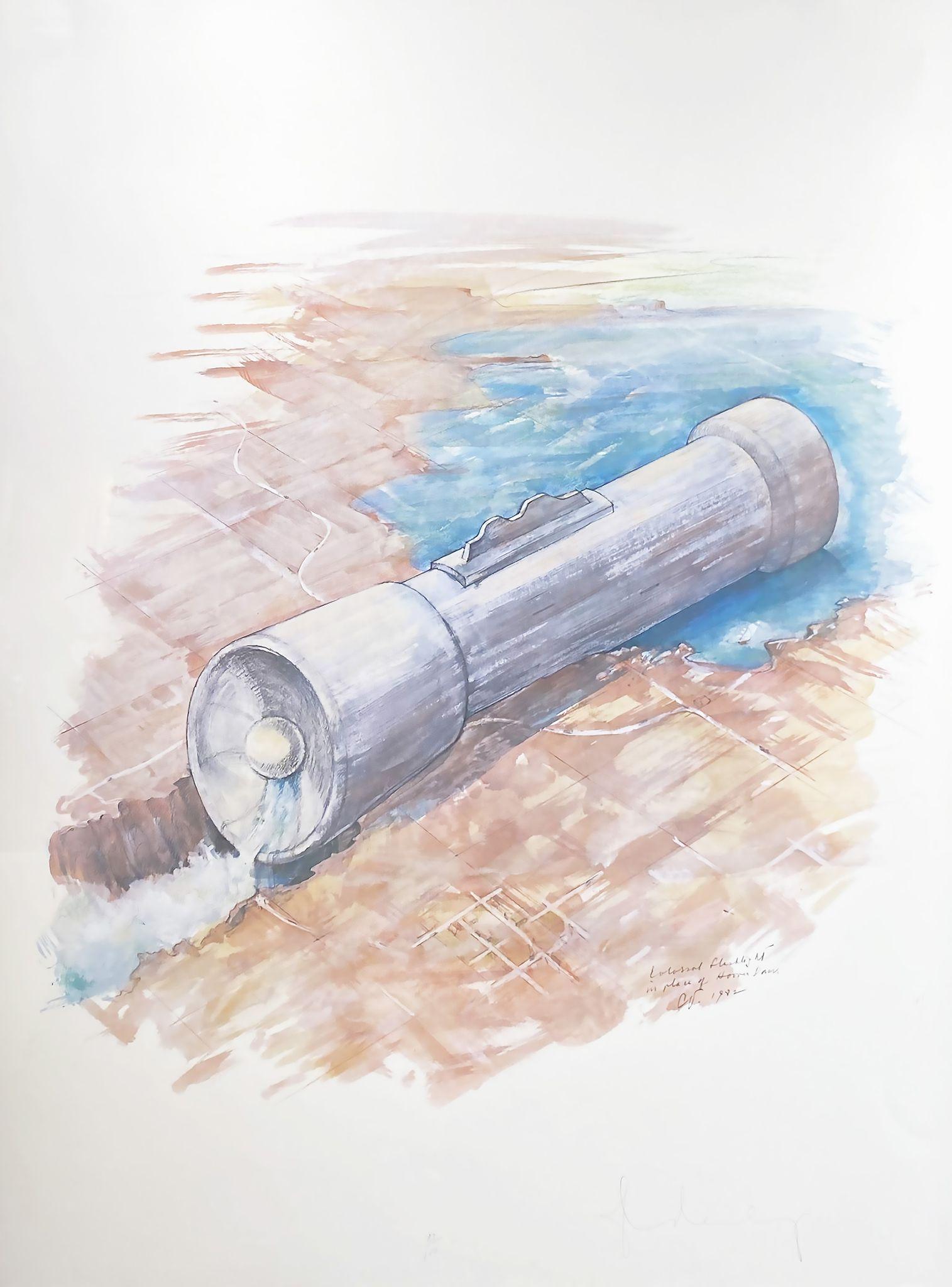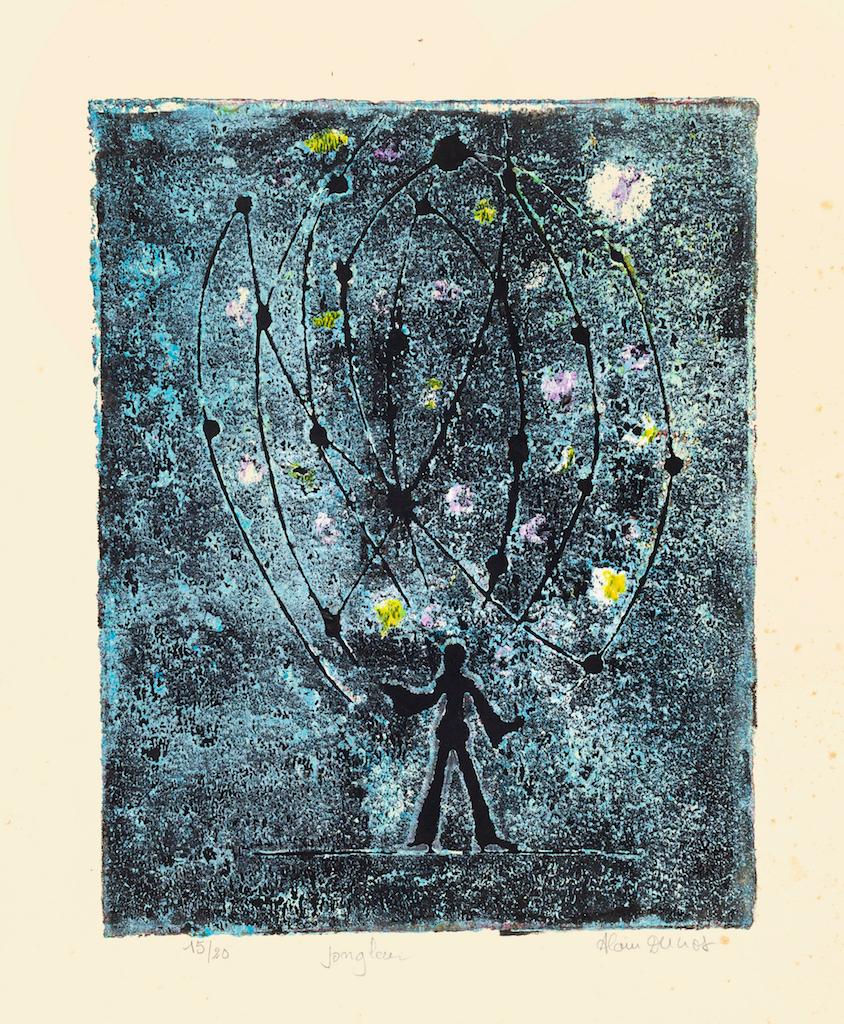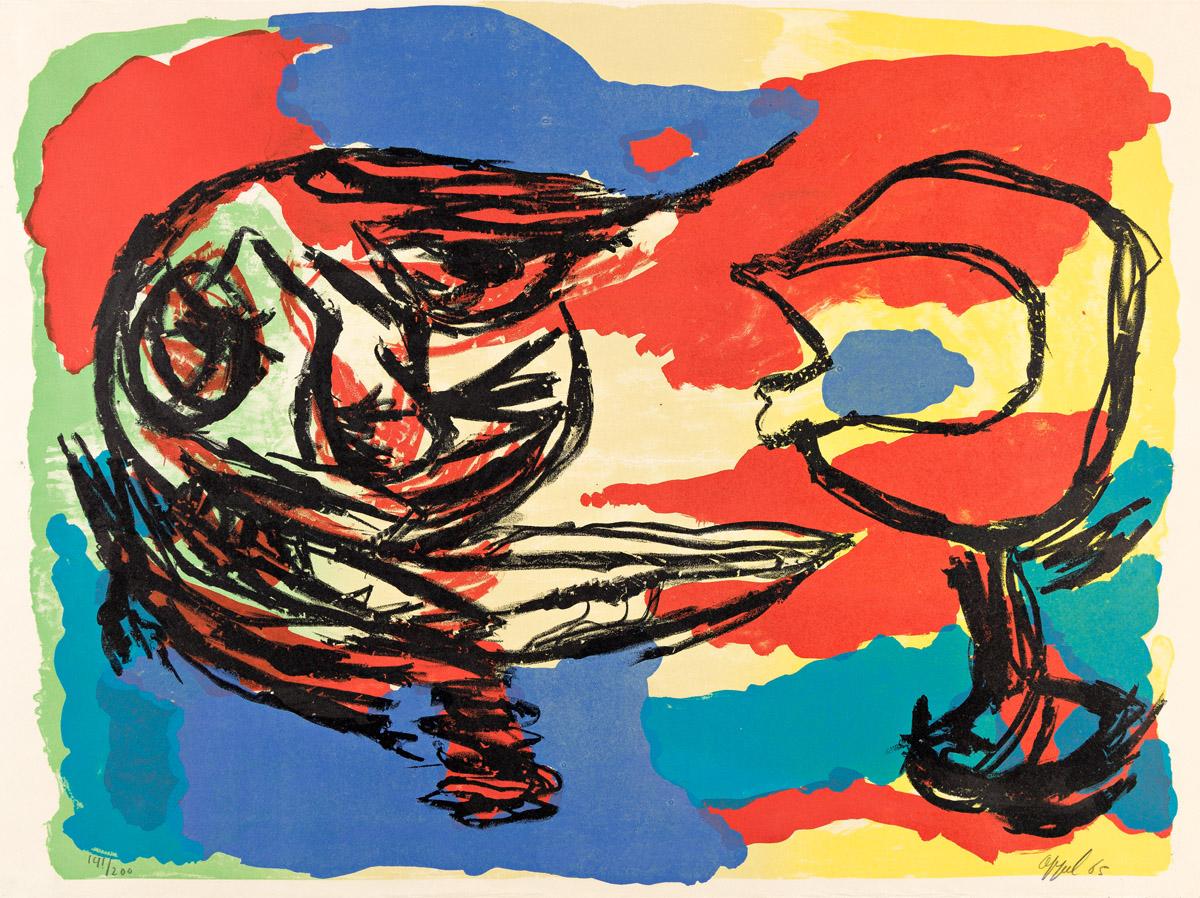Items Similar to Werkbund – Original Swiss Exhibition Poster
Want more images or videos?
Request additional images or videos from the seller
Hermann EidenbenzWerkbund – Original Swiss Exhibition Poster1938
1938
About the Item
Original Swiss Exhibition poster by Hermann Eidenbenz (lithograph, printed by Art. Institut Grafica in Basel) advertising a show of the Basel section of the Swiss Werkbund 1938 at the Gewerbemuseum, using the so-called iris printing in which multiple colors are printed in a single pass, with the colors running seamless into each other. In this way, a multicolored poster could be realized in two printing passes only (black and color). This should highlight the close linking and interdependence of graphic artists, architects, carpenters, photographers, fabricants, vendors, users…
The Swiss Werkbund was founded 1913 in the tradition of a counter-movement originating in the 1890s in England to industrialization, through which a decline in crafts had become apparent. Loveless, industrial mass production was to be combated by (still industrially manufactured!) products of refined design that expressed uniqueness and inherent beauty – by resisting (excessive) decoration. And: The representatives were convinced that good craftsmanship consists of an apprenticeship that emphasizes artistic training (or, in short: even Le Corbusier or the Bauhaus did not come out of nowhere).
To finish: “Eidenbenz” is not always (just) Hermann as there were also two brothers, Willi and Reinhold, who founded in 1933 the Atelier Eidenbenz as one of the first advertising agencies in Basel that combined graphic design and photography. While Hermann and Willi worked as graphic designers and photographers, Reinhold primarily took over the commercial management of the studio (dissolved in 1972).
- Creator:Hermann Eidenbenz
- Creation Year:1938
- Dimensions:Height: 50.4 in (128 cm)Width: 35.44 in (90 cm)Depth: 0.04 in (1 mm)
- Medium:
- Movement & Style:
- Period:
- Condition:Condition A – however, please bear in mind: this is an 80+ year old lithograph, so there are faint signs of handling etc.; backed on Japan paper.
- Gallery Location:Zurich, CH
- Reference Number:1stDibs: LU1314111198922
About the Seller
5.0
Vetted Seller
These experienced sellers undergo a comprehensive evaluation by our team of in-house experts.
1stDibs seller since 2019
10 sales on 1stDibs
Typical response time: 9 hours
- ShippingRetrieving quote...Ships From: Zurich, Switzerland
- Return PolicyA return for this item may be initiated within 3 days of delivery.
More From This SellerView All
- Modern Art at the Van Abbemuseum in Eindhoven – Original Vintage Dutch PosterLocated in Zurich, CHOriginal Vintage Poster in bright and crisp colors by the Dutch graphic design legend Wim Crouwel, advertising rather the museum's collection of works by...Category
Mid-20th Century Abstract Abstract Prints
MaterialsPaper
- Expo 1970 World Exhibition in Osaka – Original Vintage Japanese PosterBy Yusaku KamekuraLocated in Zurich, CHOriginal Vintage Event Poster created 1967 by one of the best known Japanese graphic artists, Yusaku Kamekura; in 1960 he was a founding member, then ...Category
Mid-20th Century Abstract Geometric Abstract Prints
MaterialsPaper
- Great Architecture for the Sixties – TWAs Terminal Building by Eero SaarinenBy Walter AllnerLocated in Zurich, CHOriginal Vintage Poster depicting Eero Saarinen's TWA Terminal, published 1962 by the magazine Architectural Forum to promote Modern Architecture – one of...Category
Mid-20th Century Modern More Prints
MaterialsPaper
- General Dynamics, Exhibition Dynamic America, New York – Original Vintage PosterBy Erik NitscheLocated in Zurich, CHA poster by Erik Nitsche advertising General Dynamics' exhibition "Dynamic America" held 1961 in the newly renovated General Dynamics Building (formerly the Time-Life Building) at the Rockefeller Plaza in New York where the company promoted its achievements. The background to this poster is GD's division Stromberg-Carlson, a telecommunications equipment and electronics manufacturing company, founded 1895 in Chicago and acquired 1955 by General Dynamics (resold 1982). The two Swedish Immigrants started to improve Graham Bell...Category
Mid-20th Century Modern More Prints
MaterialsPaper
- Great Architecture for the Sixties – La Tourette by Le CorbusierBy Walter AllnerLocated in Zurich, CHOriginal Vintage Poster depicting Le Corbusier's Convent of La Tourette, published 1962 by the Architectural Forum to promote Modern Architecture –...Category
Mid-20th Century Modern More Prints
MaterialsPaper
- General Dynamics, Exhibition Dynamic America, New York – Original Vintage PosterBy Erik NitscheLocated in Zurich, CHA poster by Erik Nitsche advertising General Dynamics' exhibition "Dynamic America" held 1961 at the Rockefeller Plaza in New York where the company promoted its achievements. The background to this poster is the launch 1897 of the "Holland", United States Navy's first submarine, by the John P. Holland Torpedo Boat Company, predecessor of Electric Boat...Category
Mid-20th Century Modern More Prints
MaterialsPaper
You May Also Like
- Colossal Flashlight in Place of Hoover DamBy Claes OldenburgLocated in Missouri, MOColossal Flashlight in Place of Hoover Dam, 1982 By Claes Oldenburg (Swedish, American, 1929-2022) Signed Lower Right Dated Middle Right Unframed: 23" x 22" Framed: 36.5" x 27.5" Whimsical sculpture of pop culture objects, many of them large and out-of-doors, is the signature work of Swedish-born Claes Oldenburg who became one of America's leading Pop Artists. He was born in Stockholm, Sweden. His father was a diplomat, and during Claes' childhood moved his family from Stockholm to a variety of locations including Chicago where the father was general consul of Sweden and where Oldenburg spent most of his childhood. He attended the Latin School of Chicago, and then Yale University where he studied literature and art history, graduating in 1950, the same year Claes became an American citizen. Returning to Chicago, he enrolled at the Art Institute of Chicago from 1952 to 1954 and also worked as a reporter at the City News Bureau. He opened his own studio, and in 1953, some of his satirical drawings were included in his first group show at the Club St. Elmo, Chicago. He also painted at the Oxbow School of Painting in Michigan. In 1956, he moved to New York where he drew and painted while working as a clerk in the art libraries of Cooper-Union Museum for the Arts of Decoration. Selling his first artworks during this time, he earned 25 dollars for five pieces. Oldenburg became friends with numerous artists including Jim Dine, Red Grooms and Allan Kaprow, who with his "Happenings" was especially influential on Oldenburg's interest in environmental art. Another growing interest was soft sculpture, and in 1957, he created a piece later titled Sausage, a free-hanging woman's stocking stuffed with newspaper. In 1959, he had his first one-man show, held at the Judson Gallery at Washington Square. He exhibited wood and newspaper sculpture and painted papier-mache objects. Some viewers of the exhibit commented how refreshing Oldenburg's pieces were in contrast to the Abstract Expressionism, a style which much dominated the art world. During this time, he was influenced by the whimsical work of French artist, Bernard Buffet, and he experimented with materials and images of the junk-filled streets of New York. In 1960, Oldenburg created his first Pop-Art Environments and Happenings in a mock store full of plaster objects. He also did Performances with a cast of colleagues including artists Lucas Samaras, Tom Wesselman, Carolee Schneemann, Oyvind Fahlstrom and Richard Artschwager, dealer Annina Nosei, critic Barbara Rose, and screenwriter Rudy Wurlitzer. His first wife (1960-1970) Pat Muschinski, who sewed many of his early soft sculptures, was a constant performer in his Happenings. This brash, often humorous, approach to art was at great odds with the prevailing sensibility that, by its nature, art dealt with "profound" expressions or ideas. In December 1961, he rented a store on Manhattan's Lower East Side to house "The Store," a month-long installation he had first presented at the Martha Jackson Gallery in New York. This installation was stocked with sculptures roughly in the form of consumer goods. Oldenburg moved to Los Angeles in 1963 "because it was the most opposite thing to New York I could think of". That same year, he conceived AUT OBO DYS, performed in the parking lot of the American Institute of Aeronautics and Astronautics in December 1963. In 1965 he turned his attention to drawings and projects for imaginary outdoor monuments. Initially these monuments took the form of small collages such as a crayon image of a fat, fuzzy teddy bear looming over the grassy fields of New York's Central Park (1965) and Lipsticks in Piccadilly Circus, London (1966). Oldenburg realized his first outdoor public monument in 1967; Placid Civic Monument took the form of a Conceptual performance/action behind the Metropolitan Museum of Art, New York, with a crew of gravediggers digging a 6-by-3-foot rectangular hole in the ground. Many of Oldenburg's large-scale sculptures of mundane objects elicited public ridicule before being embraced as whimsical, insightful, and fun additions to public outdoor art. From the early 1970s Oldenburg concentrated almost exclusively on public commissions. Between 1969 and 1977 Oldenburg had been in a relationship with Hannah Wilke, feminist artist, but in 1977 he married Coosje van Bruggen, a Dutch-American writer and art historian who became collaborator with him on his artwork. He had met her in 1970, when she curated an exhibition for him at the Stedelijk Museum in Amsterdam. Their first collaboration came when Oldenburg was commissioned to rework Trowel I, a 1971 sculpture of an oversize garden tool, for the grounds of the Kröller-Müller Museum in Otterlo, the Netherlands. Oldenburg has officially signed all the work he has done since 1981 with both his own name and van Bruggen's. In 1988, the two created the iconic Spoonbridge and Cherry sculpture for the Walker Art Center in Minneapolis, Minnesota that remains a staple of the Minneapolis Sculpture Garden as well as a classic image of the city. Typewriter Eraser...Category
20th Century American Modern Abstract Prints
MaterialsPaper, Lithograph
- UntitledBy Sam GilliamLocated in New York, NYA very good impression of this screenprint on hand made, hand dyed paper. Signed, dated and numbered 7 in pencil by Gilliam.Category
1970s Modern Abstract Prints
MaterialsDye, Handmade Paper, Color, Screen
- Juggler - Original Etching on Paper by Alain Ducros - 1954By Alain DucrosLocated in Roma, ITJuggler is an original etching artwork on paper realized by Alain Ducros in 1954, Hand-signed on the lower right, titled on the lower center, numbered, limited edition of 15/20 print...Category
1950s Modern Abstract Prints
MaterialsEtching
- Pablo Picasso - Painter and His Model - Original LithographBy Pablo PicassoLocated in Collonge Bellerive, Geneve, CHPablo Picasso - Painter and His Model - Original Lithograph 1964 Dimensions: 30 x 20 cm Edition of 200 (one of the 200 on Vélin de Rives) Mourlot Press, 1964 Unsigned and unumbered ...Category
1960s Modern Abstract Prints
MaterialsLithograph
- Deux TêtesBy Karel AppelLocated in New York, NYA very good impression of this color lithograph on Arches. Signed, dated and numbered 141/200 in pencil by Appel.Category
1960s Modern Abstract Prints
MaterialsColor, Lithograph
- Large Johnny Friedlaender Poster Print No TextBy Johnny FriedlaenderLocated in Surfside, FLJohnny Friedlaender (26 December 1912 – 18 June 1992) was a leading 20th-century artist, whose works have been exhibited in Germany, France, Netherlands, Italy, Japan and the United States. He has been influential upon other notable artists, who were students in his Paris gallery. His preferred medium of aquatint etching is a technically difficult artistic process, of which Friedlaender has been a pioneer. Gotthard Johnny Friedlaender was born in Pless (Pszczyna), Prussian Silesia, as the son of a pharmacist. He was graduated from the Breslau (Wrocław) high school in 1922 and then attended the Academy of Arts (Akademie der Bildenden Kunste) in Breslau, where he studied under Otto Mueller. He graduated from the Academy as a master student in 1928. In 1930 he moved to Dresden where he held exhibitions at the J. Sandel Gallery and at the Dresden Art Museum. He was in Berlin for part of 1933, and then journeyed to Paris. After two years in a Nazi concentration camp, he emigrated to Czechoslovakia, where he settled in Ostrava, where he held the first one-man show of his etchings. In 1936 Friedlaender journeyed to Czechoslovakia, Switzerland, Austria, France and Belgium. At the Hague he held a successful exhibition of etchings and watercolours. He fled to Paris in 1937 as a political refugee of the Nazi regime with his young wife, who was an actress. In that year he held an exhibition of his etchings which included the works: L ‘Equipe and Matieres et Formes. From 1939 to 1943 he was interned in a series of concentration camps, but survived against poor odds. After freedom in 1944 Friedlaender began a series of twelve etchings entitled Images du Malheur with Sagile as his publisher. In the same year he received a commission to illustrate four books by Freres Tharaud of the French Academy. In 1945 he performed work for several newspapers including Cavalcade and Carrefour. In the year 1947 he produced the work Reves Cosmiques and in that same year he became a member of the Salon de Mai, which position he held until 1969. In the year 1948 he began a friendship with the painter Nicolas de Staël and held his first exhibition in Copenhagen at Galerie Birch. The following year he showed for the first time in Galerie La Hune in Paris. After living in Paris for 13 years, Friedlaender became a French citizen in 1950. Friedlaender expanded his geographic scope in 1951 and exhibited in Tokyo in a modern art show. In the same year he was a participant in the XI Trienale in Milan, Italy. By 1953 he had produced works for a one-man show at the Museum of Neuchâtel and exhibited at the Galerie Moers in Amsterdam, the II Camino Gallery in Rome, in São Paulo, Brazil and in Paris. He was a participant of the French Italian Art Conference in Turin, Italy that same year. Friedlaender accepted an international art award in 1957, becoming the recipient of the Biennial Kakamura Prize in Tokyo. In 1959 he received a teaching post awarded by UNESCO at the Museum of Modern Art in Rio de Janeiro. By 1968 Friedlaender was travelling to Puerto Rico, New York City and Washington, D.C. to hold exhibitions. That year he also purchased a home in the Burgundy region of France. 1971 was another year of diverse international travel including shows in Bern, Milan, Paris, Krefeld and again New York. In the latter city he exhibited paintings at the Far Gallery, a venue becoming well known for its patronage of important twentieth-century artists. From his atelier in Paris Friedlaender instructed younger artists who themselves went on to become noteworthy, among them Arthur Luiz Piza, Brigitte Coudrain...Category
Mid-20th Century Modern Abstract Prints
MaterialsOffset, Screen
Recently Viewed
View AllMore Ways To Browse
Swiss Design Poster
Swiss Lithographs
Corbusier Switzerland
Basel Vintage
Swiss Graphic Design
Bauhaus Swiss
Bauhaus Poster
Corbusier Poster
Le Corbusier Posters
Le Corbusier Poster
Graphic Design Exhibition Poster
Bauhaus Vintage Poster
Le Corbusier Print
Architect Posters
Swiss Graphic Design Poster
Original Poster Art Industrial
Bauhaus Lithograph
Corbusier Lithograph





